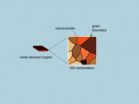(Press-News.org) Stanford University scientists have found a new, highly efficient way to produce liquid ethanol from carbon monoxide gas. This promising discovery could provide an eco-friendly alternative to conventional ethanol production from corn and other crops, say the scientists. Their results are published in the April 9 advanced online edition of the journal Nature.
"We have discovered the first metal catalyst that can produce appreciable amounts of ethanol from carbon monoxide at room temperature and pressure – a notoriously difficult electrochemical reaction," said Matthew Kanan, an assistant professor of chemistry at Stanford and coauthor of the Nature study.
Most ethanol today is produced at high-temperature fermentation facilities that chemically convert corn, sugarcane and other plants into liquid fuel. But growing crops for biofuel requires thousands of acres of land and vast quantities of fertilizer and water. In some parts of the United States, it takes more than 800 gallons of water to grow a bushel of corn, which, in turn, yields about 3 gallons of ethanol.
The new technique developed by Kanan and Stanford graduate student Christina Li requires no fermentation and, if scaled up, could help address many of the land- and water-use issues surrounding ethanol production today. "Our study demonstrates the feasibility of making ethanol by electrocatalysis," Kanan said. "But we have a lot more work to do to make a device that is practical."
Novel electrodes
Two years ago, Kanan and Li created a novel electrode made of a material they called oxide-derived copper. They used the term "oxide-derived" because the metallic electrode was produced from copper oxide.
"Conventional copper electrodes consist of individual nanoparticles that just sit on top of each other," Kanan said. "Oxide-derived copper, on the other hand, is made of copper nanocrystals that are all linked together in a continuous network with well-defined grain boundaries. The process of transforming copper oxide into metallic copper creates the network of nanocrystals."
For the Nature study, Kanan and Li built an electrochemical cell – a device consisting of two electrodes placed in water saturated with carbon monoxide gas. When a voltage is applied across the electrodes of a conventional cell, a current flows and water is converted to oxygen gas at one electrode (the anode) and hydrogen gas at the other electrode (the cathode). The challenge was to find a cathode that would reduce carbon monoxide to ethanol instead of reducing water to hydrogen.
"Most materials are incapable of reducing carbon monoxide and exclusively react with water," Kanan said. "Copper is the only exception, but conventional copper is very inefficient."
In the Nature experiment, Kanan and Li used a cathode made of oxide-derived copper. When a small voltage was applied, the results were dramatic.
"The oxide-derived copper produced ethanol and acetate with 57 percent faradaic efficiency," Kanan said. "That means 57 percent of the electric current went into producing these two compounds from carbon monoxide. We're excited because this represents a more than 10-fold increase in efficiency over conventional copper catalysts. Our models suggest that the nanocrystalline network in the oxide-derived copper was critical for achieving these results."
Carbon neutral
The Stanford team has begun looking for ways to create other fuels and improve the overall efficiency of the process. "In this experiment, ethanol was the major product," Kanan said. "Propanol would actually be a higher energy-density fuel than ethanol, but right now there is no efficient way to produce it."
In the experiment, Kanan and Li found that a slightly altered oxide-derived copper catalyst produced propanol with 10 percent efficiency. The team is working to improve the yield for propanol by further tuning the catalyst's structure.
Ultimately, Kanan would like to see a scaled-up version of the catalytic cell powered by electricity from the sun, wind or other renewable resource.
For the process to be carbon neutral, scientists will have to find a new way to make carbon monoxide from renewable energy instead of fossil fuel, the primary source today. Kanan envisions taking carbon dioxide (CO2) from the atmosphere to produce carbon monoxide, which, in turn, would be fed to a copper catalyst to make liquid fuel. The CO2 that is released into the atmosphere during fuel combustion would be re-used to make more carbon monoxide and more fuel – a closed-loop, emissions-free process.
"Technology already exists for converting CO2 to carbon monoxide, but the missing piece was the efficient conversion of carbon monoxide to a useful fuel that's liquid, easy to store and nontoxic," Kanan said. "Prior to our study, there was a sense that no catalyst could efficiently reduce carbon monoxide to a liquid. We have a solution to this problem that's made of copper, which is cheap and abundant. We hope our results inspire other people to work on our system or develop a new catalyst that converts carbon monoxide to fuel."
INFORMATION:
The Nature study was coauthored by Jim Ciston, a senior staff scientist with the National Center for Electron Microscopy at Lawrence Berkeley National Laboratory.
The research was supported by Stanford University, the National Science Foundation and the U.S. Department of Energy.
This article was written by Mark Shwartz, Precourt Institute for Energy at Stanford University.
Stanford scientists discover a novel way to make ethanol without corn or other plants
2014-04-09
ELSE PRESS RELEASES FROM THIS DATE:
Novel approach to accelerate metabolism could lead to new obesity treatment
2014-04-09
BOSTON – By manipulating a biochemical process that underlies cells' energy-burning abilities, investigators at Beth Israel Deaconess Medical Center (BIDMC) have made a novel discovery that could lead to a new therapy to combat obesity and diabetes.
Published in the April 10 issue of the journal Nature, the new findings show that reducing the amount of nicotinamide N-methyltransferase (NNMT) protein in fat and liver dramatically reduces the development of obesity and diabetes in mice.
'With this discovery, we now have a means of metabolic manipulation that could ...
A bad penny: Cancer's thirst for copper can be targeted
2014-04-09
DURHAM, N.C. – Drugs used to block copper absorption for a rare genetic condition may find an additional use as a treatment for certain types of cancer, researchers at Duke Medicine report.
The researchers found that cancers with a mutation in the BRAF gene require copper to promote tumor growth. These tumors include melanoma, the most dangerous form of skin cancer that kills an estimated 10,000 people in the United States a year, according to the National Cancer Institute.
"BRAF-positive cancers like melanoma almost hunger for copper," said Christopher M. Counter, ...
UC San Diego researchers develop bacterial 'FM radio'
2014-04-09
Programming living cells offers the prospect of harnessing sophisticated biological machinery for transformative applications in energy, agriculture, water remediation and medicine. Inspired by engineering, researchers in the emerging field of synthetic biology have designed a tool box of small genetic components that act as intracellular switches, logic gates, counters and oscillators.
But scientists have found it difficult to wire the components together to form larger circuits that can function as "genetic programs." One of the biggest obstacles? Dealing with a small ...
New 'switch' could power quantum computing
2014-04-09
Using a laser to place individual rubidium atoms near the surface of a lattice of light, scientists at MIT and Harvard University have developed a new method for connecting particles — one that could help in the development of powerful quantum computing systems.
The new technique, described in a paper published today in the journal Nature, allows researchers to couple a lone atom of rubidium, a metal, with a single photon, or light particle. This allows both the atom and photon to switch the quantum state of the other particle, providing a mechanism through which quantum-level ...
Synthetic collagen promotes natural clotting
2014-04-09
Synthetic collagen invented at Rice University may help wounds heal by directing the natural clotting of blood.
The material, KOD, mimics natural collagen, a fibrous protein that binds cells together into organs and tissues. It could improve upon commercial sponges or therapies based on naturally derived porcine or bovine-derived collagen now used to aid healing during or after surgery.
The lab of Jeffrey Hartgerink, a chemist and bioengineer based at Rice's BioScience Research Collaborative, developed synthetic collagen several years ago. The lab's analysis of KOD ...
Spike in postoperative cardiac surgery deaths may be linked to 30-day survival measurement
2014-04-09
Analyzing a national database of hospital inpatient records, a team of researchers reports an expected spike in mortality six days after cardiac surgery, but also a more surprising and potentially troubling jump in deaths at the 30-day mark.
In a report on the study, they suggest that while there could be "organic" medical reasons for the extra deaths, the more likely explanation may be an unintended consequence of putting so much emphasis on marking one-month "survival" as a key measurement of surgical success.
"One possibility for the spike is that by often measuring ...
NASA's TRMM satellite sees Tropical Cyclone Ita intensifying
2014-04-09
VIDEO:
This simulated 3-D flyby animation using TRMM precipitation radar data on April 9 shows rain falling at a rate of over 99 mm/3.9 inches per hour (red) within Ita's feeder...
Click here for more information.
Tropical Cyclone Ita has been intensifying as it tracks from Papua New Guinea toward Queensland, Australia, and NASA's TRMM satellite noticed the development of an eye feature.
NASA and the Japan Aerospace Exploration Agency's Tropical Rainfall Measuring Mission (TRMM) ...
Skulls of red and giant pandas provide insight into coexistence
2014-04-09
New research on the skulls of red pandas and giant pandas provides further explanation as to why the two species—which are not closely related but dine on the same food, bamboo, in the same geographic area—are able to coexist. Using high-resolution imaging and biting simulations, scientists at the American Museum of Natural History and the University of Málaga in Spain found that the skulls of the two panda species not only are distantly related but also have structural differences related to the way the animals chew. These substantial differences reflect distinct bamboo ...
Oyster aquaculture could significantly improve Potomac River estuary water quality
2014-04-09
Oyster aquaculture in the Potomac River estuary could result in significant improvements to water quality, according to a new NOAA and U.S. Geological Survey study published in the journal Aquatic Geochemistry.
All of the nitrogen currently polluting the Potomac River estuary could be removed if 40 percent of its river bed were used for shellfish cultivation, according to the joint study. The researchers determined that a combination of aquaculture and restored oyster reefs may provide even larger overall ecosystem benefits. Oysters, who feed by filtering, can clean an ...
Genome sequencing of MRSA infection predicts disease severity
2014-04-09
April 9, 2014 –The spread of the antibiotic-resistant pathogen MRSA (methicillin-resistant Staphylococcus aureus) remains a concerning public health problem, especially among doctors trying to determine appropriate treatment options for infected patients. Bacterial pathogens, such as MRSA, cause disease in part due to toxicity, or the bacterium's ability to damage a host's tissue. In a study published online today in Genome Research, researchers used the genome sequence of MRSA to predict which isolates were highly toxic, thus potentially personalizing the treatment of ...


